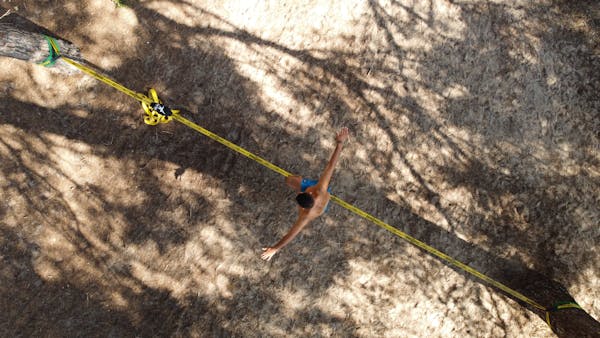Walking on Air: The Profound Mental Benefits of Slacklining
In recent years, slacklining has emerged as a popular recreational activity that challenges both body and mind. The art of balancing on a narrow, flexible webbing suspended between two anchor points not only offers physical benefits but also provides a myriad of mental advantages. As individuals step onto the slackline, they embark on a journey that transcends the physical realm, delving into the depths of the mind and offering profound mental rewards. In this article, we explore the mental benefits of slacklining and how this seemingly simple activity can lead to enhanced focus, reduced stress, increased mindfulness, and improved self-confidence.
Finding Focus and Mindfulness
The art of slacklining requires an unwavering focus and presence of mind. As individuals step onto the line, they must shut out distractions and concentrate solely on maintaining their balance. The act of balancing on the thin webbing demands full attention, leaving no room for wandering thoughts or preoccupations. This heightened focus draws practitioners into a state of mindfulness, where they become fully attuned to the present moment.
In the chaos of our modern lives, finding moments of mindfulness can be a challenge. Slacklining offers a unique opportunity to escape the noise of daily life and achieve a meditative state. By cultivating mindfulness on the slackline, individuals learn to carry this mental clarity into other aspects of their lives, enhancing overall focus and productivity.
Stress Reduction and Mental Resilience
Slacklining acts as a form of active meditation, allowing individuals to release stress and tension. The concentrated effort required to maintain balance and the repetitive nature of the activity create a calming effect on the mind. As practitioners focus on their breathing and movements, they enter a flow state, wherein worries and anxieties melt away.
Moreover, the process of learning and mastering slacklining involves facing and overcoming challenges. Each step on the line is a metaphorical step towards mental resilience. With practice, individuals learn to embrace failure as part of the learning process and develop a positive attitude towards setbacks. This newfound mental resilience not only benefits slacklining but also translates into coping with challenges in daily life.
Enhancing Cognitive Function
Slacklining is a complex physical activity that engages both the body and the mind. As individuals work to maintain their balance, their brains are constantly processing sensory information from various sources, such as the inner ear, eyes, and proprioceptors. This dynamic interplay of sensory input and motor output enhances cognitive function and improves neural connections.
Studies have shown that activities that challenge balance, like slacklining, can have a positive impact on cognitive abilities, including improved memory, concentration, and problem-solving skills. The brain's neuroplasticity allows it to adapt and rewire itself in response to new challenges, and slacklining provides an opportunity for such cognitive growth.
Boosting Self-Confidence and Self-Efficacy
As beginners progress in their slacklining journey, they experience a sense of accomplishment with each milestone reached. Whether it's taking the first few steps on the line or mastering advanced tricks, every achievement reinforces a positive sense of self. This gradual growth in skill and confidence translates to an increased belief in one's capabilities—what psychologists refer to as self-efficacy.
The sense of empowerment gained from conquering the slackline extends beyond the activity itself. It infuses individuals with a can-do attitude, encouraging them to tackle challenges in other areas of life with newfound confidence. As they push their boundaries on the slackline, they realize that limitations are often self-imposed, opening up a world of possibilities.
Fostering Social Connections
While slacklining can be a solo activity, it often brings people together in a community of like-minded individuals. Whether it's at local parks, beaches, or organized slacklining events, practitioners form connections with others who share a passion for the activity. These social interactions provide a sense of belonging and support, contributing to improved mental well-being.
In a digital age where virtual connections dominate, slacklining offers an opportunity for face-to-face interactions and genuine human connections. These social bonds not only create a supportive network but also contribute to a sense of community and camaraderie.
Cultivating Patience and Mindful Persistence
Learning slacklining is not an overnight process; it requires patience and persistence. As individuals progress from wobbly first steps to more confident strides, they develop the ability to embrace the journey rather than focusing solely on the destination. Slacklining teaches the value of consistent practice and the importance of enjoying the process.
Through the ups and downs of learning slacklining, individuals learn to be kinder to themselves, understanding that progress is made step by step. This mindful persistence extends to other aspects of life, where individuals are better equipped to face challenges with patience and determination.
Slacklining is far more than a physical activity; it is a mental journey that leads to enhanced focus, reduced stress, increased mindfulness, improved self-confidence, and a myriad of other mental benefits. By stepping onto the narrow webbing, practitioners embark on an exploration of their inner selves, finding moments of mindfulness and inner calm amidst life's chaos. Slacklining is a metaphor for life—balancing and walking through the challenges with grace and persistence. As more individuals embrace this art, they discover the profound mental rewards that extend far beyond the slackline itself, enriching their lives and shaping their minds in extraordinary ways.

